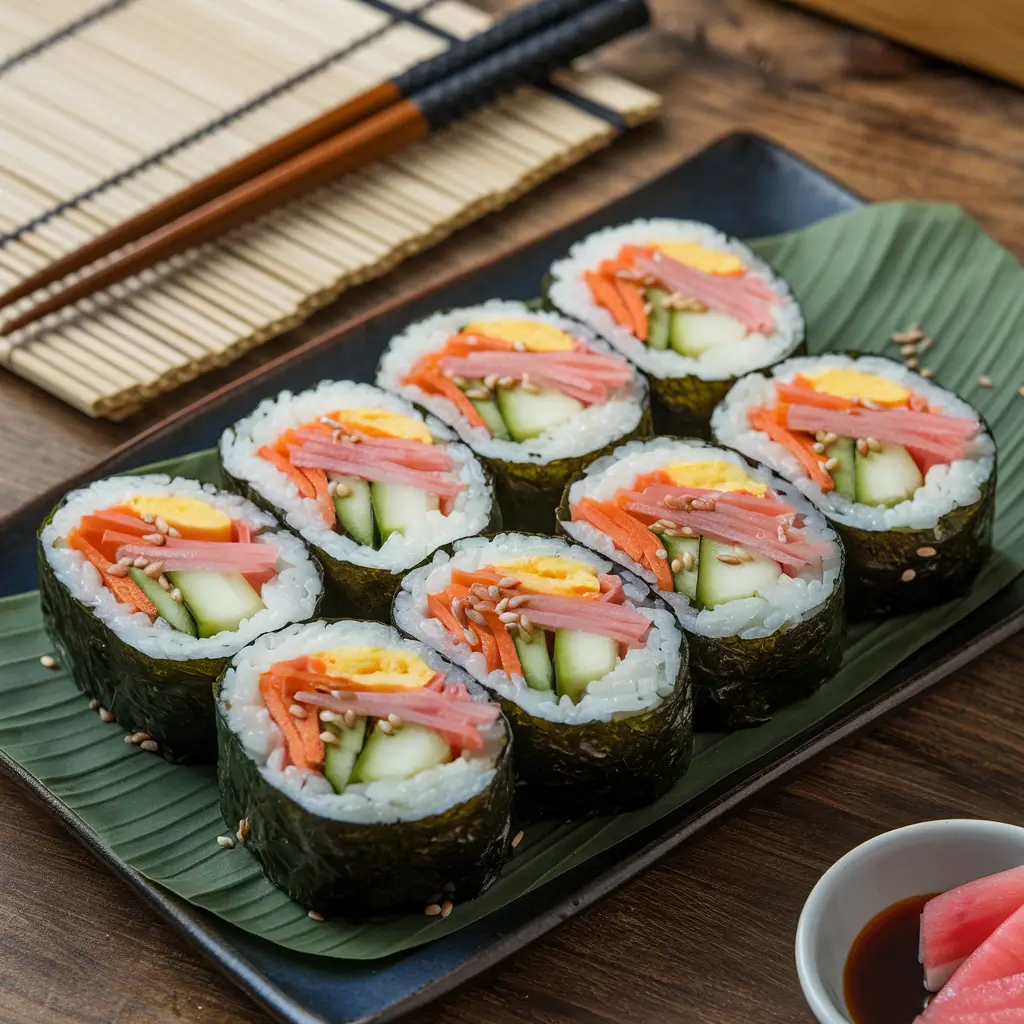Easy and delicious Korean Kimbap recipe.
Korean sushi rolls, also called kimip, are a well-known Korean food dish that features rice, seaweed, and various fillings. This is known as kimbap. This is a simple and delicious way to prepare kimbap, which can be used as both dipping sauce and consuming at home. Learn how to produce Korean kimbap with ease at home.
What’s Kimbap?
Kimbap (or gimbao) is a Korean dish that involves cooking rice, which is then coated with sesame oil and salt, then being covered with seaweed (gim), along with various vegetables, eggs, fish, or meat. The difference between kimbap and Japanese sushi is that the former uses raw fish, while the latter relies on cooked and seasoned ingredients.
Korean street food stalls, markets, and lunchboxes often offer Kimbap, which is a staple dish in Korean cuisine. It’s considered a quick, healthy meal to have on hand.’
The History of Kimbap.
Kimbap’s history is fascinating and often questioned about. According to some, it is believed to have been influenced by Japanese makizushi (sushi rolls) that were introduced in Korea when they were under the Japanese rule. However, some contend that Koreans have been using seaweed to wrap rice for centuries before the Japanese arrived.
Regardless of its origins, kimbap has become a distinctive and significant element of Korean cuisine, with an age-appropriate audience.
How will you make this kimbap recipe good?
- Easy-to-make: Quickly prepare with basic ingredients.
- Perfection: You can add your own fillings.
- Ideal for meal preparation: Keeps food fresh for hours, making it ideal for lunch boxes or picnic tables..
- A balanced diet: Rich in essential nutrients such as vegetables and proteins.
- Pricey: Contains essential pantry ingredients that can be purchased at any store.
Kimbap Recipe Details.
- Cuisine: Korean.
- Prep Time: 20 minutes.
- Cook Time: 15 minutes.
- Total Time: 35 minutes.
- Four rolls is enough for a total of 4 people to share.

Easy Korean Kimbap recipe
Description
Kimbap (or gimbao) is a Korean dish that involves cooking rice, which is then coated with sesame oil and salt, then being covered with seaweed (gim), along with various vegetables, eggs, fish, or meat. The difference between kimbap and Japanese sushi is that the former uses raw fish, while the latter relies on cooked and seasoned ingredients.
Ingredients
For the Rice:
For the Fillings:
For Rolling and Garnishing:
Instructions
-
Prepare the Rice.
- Let the short-grain rice cool down while it's still cooking.
- Combine it with sesame oil and salt. The taste of the rice is improved and it becomes more manageable.'".
-
Prepare the Fillings.
- Carrots can be cooked in a pan with some oil, until they are soft.
- Slice cucumber into thin strips and pat dry.'...
- The process of egg omelette involves beating the eggs and then cooking them until they are thin, then sliced into strips.
- Rinse the spinach and drain any excess water, then rub it in with salt and sesame oil.
- Make imitation crab sticks by cooking them raw or in a pan-fried dish for added flavor.
- If beef is being used, add some seasoning to it, along with a touch of soy sauce, sugar, and garlic. To create a creamy texture, combine canned tuna with mayonnaise if using tuner. Note:
-
Assemble the Kimbap.
- Lay a seaweed-like gibo inward on ice with your palm over the top of.
- Cover the top of seasoned rice with an inch allowance. take on side.
- ingredients in a line running from the bottom third of rice.
- Apply light pressure and rolling motion while utilizing the bamboo mat to tightly roll the kimbap from the bottom up.
- Roll over and seal with seaweed.
-
Slice and Serve.
- The roll is brushed with sesame oil for added shine. Set aside and enjoy!
- Use a sharp knife to slice into small portions (reuse sponging with ice for better adhesion).
- Add sesame seeds to the mixture and serve!
Note
Variations of Kimbap.
- For a cheese-like texture, add some crumbles of cheese.
- The addition of gochujang (Korean chili paste) or spicy tuna is a must-have for spicy Kimbap.
- Using tofu, mushrooms or avocado instead of meat is how the vegetarian Kimbap is.
- The Korean marinated beef is used as the filling in Bulgogi Kimbap.
Tips for the Best Kimbap.
- It's better to roll it with freshly cooked, mildly browned rice.
- Ensure that the roll remains soft and firm by not overcooking.
- Allow to cool roll in the fridge before cutting into slices. Set aside.
- Wipe out a clean cloth with pliers after every slice.
- Get creative with fillings! Consume tuna, bulgogi and cheese or try spicy kimchi.
